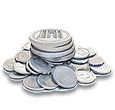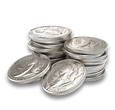🪙 How to Find Out the Value of a Coin – A Complete Guide for Collectors and Investors
- GoldsilverJapan

- Oct 6
- 4 min read
Whether you’ve inherited a coin collection, discovered an interesting coin in your travels, or are considering buying or selling one, the big question is always the same:
“What is this coin worth?”
The value of a coin can vary widely based on its rarity, condition, demand, and historical background. This article walks you through six reliable ways to determine a coin’s value, combining traditional techniques and cutting-edge tools like Coinpedia and GoldSilverJapan AI—two growing resources for collectors worldwide.
1️⃣ Identify the Coin: Country, Year, and Type
The first step in evaluating any coin is identifying its basic characteristics:
Country of issue (e.g. USA, Japan, UK)
Year of mintage (check both obverse and reverse)
Denomination (e.g. 1 Dollar, 100 Yen)
Metal content (gold, silver, nickel, copper, etc.)
Unique features (designs, inscriptions, mintmarks)
Once these are identified, you can match the coin to existing catalogs and databases.
💡 Tip: Use a magnifying glass or macro camera if inscriptions are small or hard to read.
2️⃣ Evaluate the Coin’s Condition (Grading)
Coin value is heavily influenced by condition, also known as “grade.” A higher-grade coin, especially if uncirculated, will command a significantly higher price.
📊 Common U.S. Coin Grading Scale (Sheldon Scale):
Grade | Meaning |
MS (Mint State) 60–70 | Uncirculated |
AU (About Uncirculated) 50–59 | Minor wear |
XF (Extremely Fine) 40–49 | Slightly worn |
VF (Very Fine) 20–39 | Noticeable wear |
F, G | Heavily circulated |
🎯 Coins graded MS65 or higher often attract collector premiums.
3️⃣ Check for Third-Party Authentication
Coins that are certified by trusted grading services like PCGS (Professional Coin Grading Service) or NGC (Numismatic Guaranty Company) are generally easier to value and more trusted by buyers.
✅ Why certification matters:
Guarantees authenticity
Provides a clear, standardized grade
Easier to compare with market prices
Enhances resale value
Certified coins come in tamper-evident holders with unique serial numbers you can verify online.
4️⃣ Use Online Tools and Market Data to Check Prices
Once you know the coin’s identity and condition, you can check its current market value. Several tools are available to help:
🔍 Method 1: Price Databases from Official Grading Services
PCGS Price Guide
NGC Coin Explorer
These sites let you enter the coin’s serial number (if graded) and display estimated retail and auction values.
🧠 Method 2: Use AI Tools and Apps for Value Estimates
Newer tools harness AI to make coin valuation easier and more accurate.
Leading Platforms:
Tool | Feature |
Coinoscope | Visual image recognition for coin ID |
CoinSnap | Photo-based grading and estimates |
Coinpedia × GoldSilverJapan AI | Text-based lookup for coin type, history, and market price |
💡 What Is Coinpedia × GoldSilverJapan AI?
Coinpedia × GoldSilverJapan AI is a text-input-based coin research assistant. You simply enter the coin’s name, year, and country, and the AI provides:
Coin background and classification
Rarity level and historical significance
Estimated value based on public records
Links to relevant pricing sources or sales history
Although it does not support photo input, its breadth of data makes it an excellent tool for quickly assessing market positioning, especially for internationally traded coins.
The platform is developed in collaboration with GoldSilverJapan, a global dealer specializing in high-grade investment coins. The AI is designed to support major languages and caters to both casual collectors and serious investors.
5️⃣ Get Quotes from Multiple Buyers or Dealers
If you're thinking of selling your coin, the smartest move is to get multiple quotes.
Most coin dealers offer free appraisals
Many shops offer mail-in or in-person evaluations
Comparing 2–3 quotes can reveal a fair market value range
🔧 Among reputable dealers, GoldSilverJapan is known for providing consistent, data-backed appraisals and competitive buy offers—especially for graded coins from PCGS or NGC.
6️⃣ Study Auction Records for Real-World Pricing
Auction data gives you real-world proof of what buyers are willing to pay.
Top auction houses to consult:
Heritage Auctions
Stack’s Bowers
Great Collections
Sixbid
Numisbids
Biddr
These platforms allow you to filter by coin type, grade, and sale date, so you can compare recent hammer prices.
🧠 Don’t just check high prices—review low and average prices to understand the value spectrum.
⚖️ Factors That Influence Coin Value
Factor | Description |
Rarity | How many exist, especially in high grades |
Condition (Grade) | Affects both aesthetic and market appeal |
Authentication | Certified coins are more trusted |
Demand | Collector interest varies by coin, region, and trend |
Story | Historical significance, commemorative ties, famous owners |
📋 Value Checklist: Before You Buy or Sell
✅ Identify the coin’s type and date✅ Evaluate its physical condition✅ Check if it’s certified by PCGS or NGC✅ Look up the current market value using price guides✅ Use Coinpedia × GoldSilverJapan AI for additional data✅ Request quotes from multiple dealers✅ Review auction results for reference
🔄 What to Do Once You Know the Value
Depending on your goals, you may choose to:
Hold the coin as a long-term investment
Sell it at a favorable price point
Trade or upgrade it for a better example
Get it graded if not already certified
🧭 Final Thoughts: Value Is More Than Just a Number
A coin’s value is part art, part data, and part psychology.
Combining traditional methods like grading and auction research with smart digital tools like Coinpedia × GoldSilverJapan AI gives collectors and investors a major edge.
With the right information in hand, you can buy, sell, or hold your coins with confidence—and maybe even uncover a hidden gem in your collection.








Comments